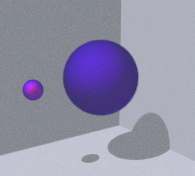 Light
Bullet Home Page
Light
Bullet Home Page Light
Bullet Home Page
Light
Bullet Home PageThe following Web pages discusses our research into the beautiful phenomena of "light bullets," intense stable spherical pulses of laser light travelling through certain bulk glass and gaseous media. We think that regardless of one's scientific background, the movies and images presented below are extremely aesthetically pleasing. Every attempt has been made to keep the sections that follow as simple as possible, but to paraphrase Einstein, no simpler. The colour coding in the movies and images represents the intensity of the laser light. It is important to realize that actual light bullets, which are approximately a few millimeters in diameter, do not have well-defined boundaries - the sharp edges are an artifact of the visualization process. Finally, the simulations are B conducted in a reference frame that is moving at a velocity in the vicinity of 0.6 times the speed of light. That is, don't expect to see a light bullet floating stationary in front of you in the near future!
If you appreciate this attempt to bring some modern physics to the general public, please send along your comments. In addition, feel free to forward any questions you might have.
Enjoy.
Darran Edmundson and Richard Enns
Department of Physics,
Simon Fraser University
British Columbia, Canada
I was observing the motion of a boat which was rapidly drawn along a narrow channel by a pair of horses, when the boat suddenly stopped - not so the mass of water in the channel which it had put in motion; it accumulated round the prow of the vessel in a state of violent agitation, then suddenly leaving it behind, rolled forward with great velocity, assuming the form of a large solitary elevation, a rounded smooth and well-defined heap of water, which continued its course along the channel apparently without change of form or diminution of speed. I followed it on horseback, and overtook it still rolling on at a rate of some eight or nine miles an hour, preserving its original figure some thirty feet long and a foot to a foot and a half in height. Its height gradually diminished, and after a chase of one or two miles I lost it in the windings of the channel. Such, in the month of August 1834, was my first chance interview with that singular and beautiful phenomenon ...
It was a further fifty years until two Dutchmen, Korteweg and de Vries, developed a nonlinear partial differential equation to model the propagation of shallow water waves applicable to situation that Scott-Russell fortuitously witnessed. (While a 1984 attempt to recreate the phenomena on the original site was a complete failure, a more recent attempt was successful.) This famous equation is known simply as the KdV equation. (Note, the very slowly diminishing height of the water wave that Scott-Russell observed is due to "frictional" losses and is not taken into account in the standard KdV equation.) A key feature of KdV is that the speed of solitary waves is proportional to their height. The obvious question then arises: what happens when a taller solitary wave overtakes a shorter (and therefore slower) solitary wave; in particular, do the individual pulses survive the collision? For nearly seventy years, an article of faith in the physics community was that a collision involving two solitary waves would destroy the otherwise stable input pulses due to the nonlinear nature of the interaction. It was not until the late 1960s that Norman Zabusky and Martin Kruskal numerically discovered that KdV solitary waves maintained their identity following collisions, the incredulous duo reporting that "here we have a nonlinear physical process in which interacting localized pulses do not scatter irreversibly." Zabusky and Kruskal coined the term 'soliton' to reflect the particle-like nature of these robust travelling solitary waves. (In 1967, this numerical curiosity was placed on a firm mathematical basis with Gardner et al.'s discovery of the inverse-scattering-transform method.)
Since their discovery a mere thirty years ago, solitons have been invoked to explain such diverse phenomena as
At this point, it is useful to introduce the concept of a refractive index. Simply, the refractive index is the speed of light in empty space divided by the speed of light in the medium of propagation. In introductory physics courses, students are taught that a typical glass has a refractive index of around 1.4, i.e. the speed of the light travelling through the glass is only 70% of the speed of light in empty space. Students then learn that a light ray entering a medium with a higher refractive index bends towards the vertical - this is the effect which makes a straw in a glass of water seem to bend at the air/water interface. A further correction to the refractive index is that it changes slightly depending on the colour (wavelength) of the incident light. As a result of the wavelength dependence of the refractive index, rainbows are produced, and a prism is able to separate "white light" into its component colours. A less desirable result is that since different colours propagate at different speeds, a pulse (which contains an assortment of colours) will spread as its various colour components (which initially started out together) arrive at their destination at differing times. This latter effect is known as dispersion.
Given that the refractive index depends on frequency, it is not too much of a jump to imagine that it is also dependent on the intensity of the light passing through the medium. That is, at every point in the material, the refractive index depends on the intensity of the light at that point. Since a beam is most intense at its centre, the refractive index would be highest at the middle and decrease as one moved outwards towards the beam edge. We can now explain the self-focusing of intense cylindrical beams! - light rays travelling at a given radius have a natural tendency to bend inwards towards areas of increased index of refraction.
It is important to realize that the mere existence of solitary waves and this hand-waving "balance of forces" argument does not mean that these pulses will propagate without change. A reasonable analogy is that of a damped simple pendulum. (The damping is introduced to rid the pendulum of its annoying tendency to tick-tock interminably.) The natural inclination of such a pendulum is to hang straight down - any perturbation from the vertical results in motion back towards the equilibrium point. Note, however, that mathematically, this pendulum possesses a second point of equilibrium, namely the inverted position. As can well be imagined, this "fixed point" is unstable, any small perturbation resulting in the pendulum bob flopping back down to the lower position. Thus, while the inverted position is a mathematical equilibrium point, it is physically unstable. (This is not an attack on mathematics, one can show mathematically that the inverted point is unstable.)
Indeed, to return to the light bullet problem, the standard nonlinear materials wherein the refractive index is strictly proportional to the intensity of light do not allow stable light bullets. Thus, we have considered alternative refractive index models that should (and do) permit the propagation of stable light bullets. And just like for KdV, once we have stable isolated bullets, the next obvious step is to collide them and observe what happens!
Whereas true solitons behave like those of the KdV equation, surviving collisions with no loss of energy, our emerging light bullets are found to possess less energy than the input pulses. Thus, light bullets are not true solitons in the strict mathematical sense of the term. However, in the physics literature and despite the protestations of a few purists, such robust pulses have pragmatically become known as solitons.
The colours are proportional to the intensity of the laser light, blue indicating lower intensity through to red and white higher intensity regions. As mentioned in the preface, the sharp edges of the light bullets are an artifact of the visualization process, regions possessing an intensity below an arbitrary cutoff being rendered transparent. (It may help to think of the analogous problem of trying to render a human head. In order to visualize one's skull, it is necessary to strip away the lower density regions of the skin and underlying tissue.)
The Canonical Collision |
||
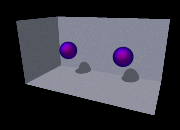
|
In this simulation, two light bullets are initially separated
in space (shown at left) but have opposing velocities in the moving reference
frame such that they collide. (In the laboratory reference frame, the
right-most light bullet is travelling faster than the left-most bullet,
the collision occurring when it overtakes the slower pulse.) The light
bullets survive
the nonlinear collision although a fraction of the energy is dissipated into
the surrounding volume; this released radiation is not evident in the
images due to the colour cutoff mentioned earlier in the preface. (still images, 240 kb animation or 79 kb animation) |
|
Soliton Fission |
||
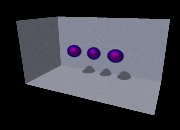 |
Here, two light bullets pass through each other
in a quasi-soliton fashion. However, rather than shed energy into the
surrounding volume, as they leave the collision the bullets "pinch off" to
form a third stationary state as shown at left. (still images, 202 kb animation or 66 kb animation) |
|
Soliton Fusion |
||
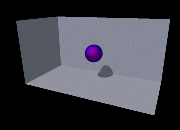 |
If you have viewed the previous two animations, you will have noticed
that just after the solitons pass through one another, their speed is reduced
as they struggle to escape what is apparently an attractive binding force. For
incident velocities slightly below those above, the emerging bullets come
to a complete standstill after the collision and then subsequently fuse to
form a single soliton state (shown at left). (still images, 322 kb animation or 103 kb animation) |
|
Soliton Tunnelling |
||
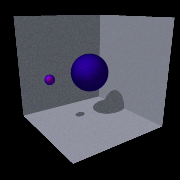 |
Several of the refractive index models we considered admit so-called
bistable solitons, light bullets with the same energy content but radically
different radial profiles. For example, the pulses at left contain the
same energy content despite their grossly disparate sizes. This
is possible because the smaller bullet has a much more intense center
with respect to the larger soliton. This simulation depicts a collision
between two such bistable light bullets, the smaller bullet burrowing
through the middle of the larger diffuse bullet. (still images, 406 kb animation or 120 kb animation) |
|
Spiralling Light Bullets Leading To Fusion |
||
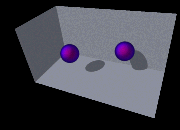 |
To this point, the simulations shown all possess a cylindrical symmetry
axis and we have not made full use of the 3-dimensional nature of the
problem. In this simulation, we allow two light bullets to interact that
are offset slightly such that they do not collide "head-on." However, due
to the attractive force between the bullets, the two pulses do not pass by
without deviation but instead go into orbit about one another. As
they rotate, the orbit decays until the bullets fuse into a single
rotating soliton state. (still images, 276 kb animation or 89 kb animation) |
|
Spiralling Light Bullets Without Capture |
||
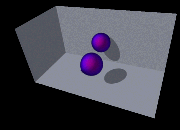 |
If the offset is increased slightly from that above, the light bullets
rotate about one another but capture and fusion does not occur, the pulses
leaving the simulation with transverse velocities (shown at left). In the
laboratory frame of reference, these sideways velocities are superimposed
on a fast longitudinal motion. (still images, 364 kb animation or 115 kb animation) |
|
Soliton Repulsion and Scattering Experiments |
||
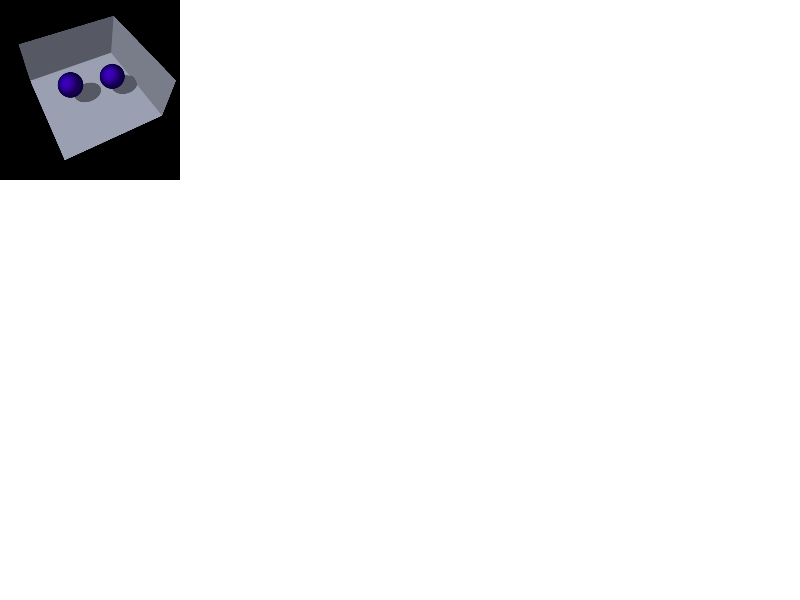 |
The attractive force between the solitons can be converted to
a repulsive force as indicated in the following simulation where two
light bullets bounce off of one another. In the language of physics, this
is a scattering experiment and can be used as a probe of the force between
the interacting solitons. We have performed a number of such simulations
at various offsets, incident velocities, and bullet energies which were
then used to extract the precise mathematical form of the force law. (still images, 239 kb animation or 78 kb animation) |
|
Unstable Halo States: One-Halo Simulation |
||
 |
In addition to the qualitatively similar Gaussian-like (approximately
bell-curve shaped) solitary waves discussed so far, the governing equation
also admits so-called "halo states" comprised of a bright central ball
surrounded by a number of spherical shells. In analogy with the inverted
pendulum mentioned earlier, these states are found to be unstable to
propagation, the smallest amount of noise tickling the solution and causing
it to decay into a number of "normal" light bullets. This first simulation
depicts the propagation of the one-halo state shown at left with an octant
removed to see the internal structure. (still images, 424 kb animation or 130 kb animation) |
|
Unstable Halo States: Two-Halo Simulation |
||
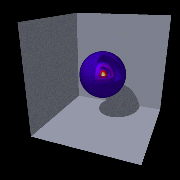 |
Our final simulation is the unstable propagation of the two-halo state
shown at left. Of particular interest is the soccer-ball-like structure
that forms out of the outer halo and the pulsing behaviour of the
two light bullets that form at the lower right of the animation. (still images, 574 kb animation or 181 kb animation) |
| Email comments to dEdmundson@bigfoot.com. Last updated on March 25, 1996. |